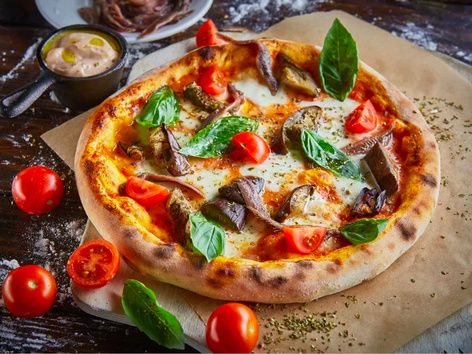Ukrainian borscht, French baguette, Neapolitan pizza: products and dishes under the protection of UNESCO

The dishes that are known all over the world and familiar to everyone are included in the UNESCO List of Intangible Cultural Heritage
In addition to architecture, monuments and other types of cultural heritage, UNESCO also protects intangible culture. The List of Intangible Cultural Heritage includes holidays, traditions, painting, as well as cuisines of certain countries and even individual dishes. Inclusion in the list means that the dish is protected by mankind from extinction and any encroachments on it are undesirable.
In 2022, Ukrainian borscht and French baguette were added to the list of dishes requiring immediate protection. Today we will tell in more detail what other food the UNESCO committee has taken under its reliable wing, some dishes will turn out to be quite familiar and familiar to many of us.
Ukrainian borscht
In July 2022, the Intergovernmental Committee for the Protection of Intangible Cultural Heritage added Ukrainian borscht to the UNESCO List of Intangible Cultural Heritage. According to the Minister of Culture of Ukraine, Oleksandr Tkachenko, the "Culture of making Ukrainian borscht" was taken under protection. This event became quite significant for Ukraine, because the controversy about the belonging of borscht was conducted in social networks since 2019 after a provocative statement on the official Twitter account of the Ministry of Foreign Affairs of russia, where the spokesperson indicated that borscht belongs to russian cuisine.
There is a recipe for borscht in Ukrainian records from the distant past, but this dish has undergone many transformations even today. No two housewives will ever cook the same borscht, each one is special.
French baguette
The French baguette became a world heritage in December 2022. UNESCO has assigned the appropriate status to "Traditions of baguette making and the way of life that surrounds it." This bakery product is so iconic for France that more than 6 billion baguettes are baked in the country every year. Despite the fact that the ingredients are usually the same, each bakery bakes it in its own way, so the country even holds baguette preparation competitions.
Armenian lavash
Armenian pita bread has been under protection since 2014. Thin Armenian bread is one of the oldest types of bread. Lavash is served with almost every dish. An interesting tradition is to bake pita bread 3-4 months in advance, the dried bread is sprinkled with water, heated, and it becomes fresh again. Lavash is baked in a tandoor.
However, fresh unleavened bread, which is made in the form of a thin cake, is also common among the Turkic peoples and other inhabitants of the Caucasus. Therefore, in 2016, Azerbaijan, Iran, Kazakhstan, Kyrgyzstan and Turkey submitted a joint application to UNESCO, in which they declared their rights to the dish. Now there are two lavash on the UNESCO list. Armenian pita bread differs from other types only in its round shape.
Uzbek and Tajik pilaf
Of course, pilaf is popular not only in Uzbekistan and Tajikistan, it is found in the cuisine of Afghanistan, Azerbaijan, Kazakhstan, Turkmenistan, Iran and even India. However, it was the Tajiks and Uzbeks who submitted a request to UNESCO and in 2016 the dish was included in the List of Intangible Cultural Heritage.
Dolma
Dolma is another dish of oriental cuisine, which is common in many countries, but it is included in the UNESCO list as a part of Azerbaijani cuisine. The dolma has been under the care of the organization since 2017.
An interesting fact is that dolma is not necessarily grape leaves with rice or minced meat. Translated from the Turkic language, "doldurma" means stuffed, so even cabbage leaves stuffed with rice belong to this category of dishes.
Croatian gingerbread
Gingerbread, which is also known as Croatian licitars, is a real gastronomic symbol of Croatia. It was included in the List of Intangible Cultural Heritage of UNESCO in 2010 due to the beauty of its design. Gingerbread is baked for Christmas. Most often, it is red, has a heart shape and is decorated with an ornament. In the center is a mirror, it is inedible. Croatian gingerbread art has its roots in the 16th and 17th centuries, but to this day the recipes have been preserved almost in their original form.
Cabbage kimchi
Cabbage kimchi - fermented, i.e. fermented according to a special recipe, Peking cabbage is the national dish of Korea. However, kimchi can be prepared not only with cabbage, but also with any other vegetable that is fermented using salt, chili pepper, sesame oil and chotkal - a brine based on seafood. In Korea, it is believed that kimchi cabbage has a health effect, helps to lose weight. This type of fermentation was added to the UNESCO List in 2013. It is interesting that both South and North Korea celebrated this event.
Neapolitan pizza
Neapolitan pizza made the list in 2017. The intangible heritage includes the art of Neapolitan pizzaiolo, which is passed down from generation to generation. Also, the recipe for a real Neapolitan pizza is special. The dish is prepared in a strict sequence and must be baked in a wood-burning oven with constant rotation. The ingredients are local products, the cheese is exclusively mozzarella from the milk of black buffaloes, and the plum-shaped tomatoes of the San Marzano variety, grown on the slopes of Vesuvius.
Georgian wine in kveri
Kveri is a Georgian method of making wine in large jugs without handles. It was added to the List of Intangible Cultural Heritage in 2013. Grapes with skin, seeds and even twigs are placed in the vat, thanks to which it begins to actively ferment. It is the kveri that are buried in the ground, and the lid is covered with clay. The cooking method has no analogues in the world and is environmentally friendly.
Belgian beer
Belgian beer was added to the UNESCO World Heritage List in 2016. There are thousands of types of beer and hundreds of breweries in the country.
Turkish coffee
Turkish coffee was added to the UNESCO World Heritage List in 2013. The specialty of coffee lies in the preparation technology. Real Turkish coffee is prepared in a copper cezva (another name is Turkish coffee). Roasted grains should be ground as hard as possible, practically into dust. Thanks to this method, the coffee becomes softer, more aromatic and does not lose its strength.
The cuisines of certain nations are also included in the List of Intangible Cultural Heritage of UNESCO.
Mexican cuisine
Mexican cuisine first gained wide popularity in the United States, from where it spread throughout the world. Currently, burritos, tacos, enchiladas (corn-wheat breads with fillings) and guacamole are quite common dishes in many countries. UNESCO took Mexican cuisine under its protection in 2010. The main ingredient in many dishes is chili pepper, thanks to which Mexican cuisine is considered the hottest in the world. Also, many recipes have come down to us since the times of the Mayans and Aztecs.
Japanese cuisine (Wasyoku)
In 2013, the Wasyoku culinary tradition was added to the UNESCO List of Intangible Cultural Heritage. It is interesting that the classic culinary dishes of Japan are not sushi and rolls, but soups based on meat or fish broth and rice. In the dishes of Japanese cuisine, respect for nature and traditions is noted, products are minimally processed, the flavors are pure, without the addition of active sauces or spices.
French cuisine
Breakfast, lunch or dinner in France is a real culture. It was French traditions that were included in the List of Intangible Cultural Heritage. During a meal, everything is important - following the rules of serving dishes, setting the table, selecting drinks, especially wine, the duration of the dinner, etc.
Malawi cuisine
Malawi is a country in East Africa whose cuisine is based on cereals. Malawians love different types of porridge: nsimu - a thick porridge made from corn flour, or kondovole - cassava porridge. The country also prepares a drink made from fermented millet or sorghum (tobwa) and stewed pumpkin leaves with peanut flour (mhwani). In 2017, the cuisine of Malawi was added to the List of Intangible Heritage.
We will remind you! Earlier we wrote that Ukrainian culture is becoming more and more popular in the world. Restaurants of Ukrainian cuisine operate in many countries of the world, some have been open for a long time, others were already opened during the war. Find out about where you can taste Ukrainian dishes abroad in our article at the link.
Recommended articles
2 min
Travel
2 min
Popular
Ukrainian football legends: career highlights and support for Ukraine during the war
Football players Blokhin, Belanov, Shevchenko, Yarmolenko and Shovkovsky - career, successes and support of the Motherland during the war
10 Dez. 2022
More details1 min
Ausbildung
How many people around the world study the Ukrainian language: annual report
According to the Duolingo application, in 2022 there was a surge among those who wanted to know the Ukrainian language. Demand is observed even in countries far from us
11 Dez. 2022
More details1 min
Krieg
The phenomenon of Ukrainian donations, or how Ukrainians collect millions in a war-torn country
How the true culture of donation was born in Ukraine and why Ukrainians have become one of the most united nations in the world
11 Dez. 2022
More details

